#thylacosmilus atrox
Text

Thylacosmilus atrox, an extinct metatherian mammal that superficially resembles the saber-toothed felids, but is instead related to modern marsupials.

#art#digital art#paleoart#chordata#mammalia#mammals#sparassodonta#thylacosmilidae#thylacosmilus#thylacosmilus atrox#miocene#huayquerian#montehermosan#pliocene#south america
21 notes
·
View notes
Text
Despite having eyes as wide-set as a cow's and surprisingly long upper-canine teeth with roots tunneling deep into its skull, the "marsupial sabertooth" proved to be an effective carnivore, a new study finds.
This ferocious marsupial is an extinct mammal from South America scientifically known as Thylacosmilus atrox. Scientists from Argentina and the United States examined computed tomography (CT) scans of the skulls of three of the large predators, which would have weighed roughly 220 pounds (100 kilograms) and went extinct about 3 million years ago. The team noticed that the animal's odd cranial anatomy stood out compared with other carnivores, such as dogs and cats, whose eyes are more forward-facing to help them track prey, according to the study published Tuesday (March 21) in the journal Communications Biology.
19 notes
·
View notes
Text
Desperately in need of one of these lil guys
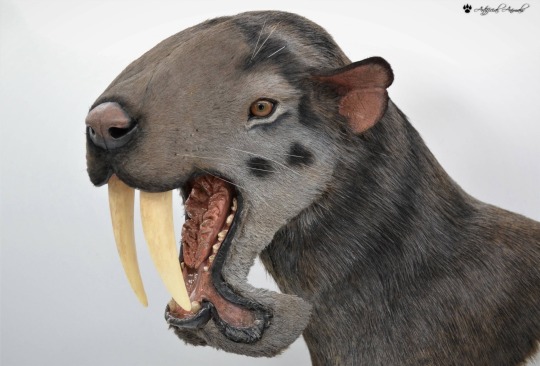
2 notes
·
View notes
Text

Thylacosmilus atrox was a sparassodontan mammal from the Late Miocene and Pliocene of South America. Sparassodonts were metatherians, cousins of the marsupials and distantly related to placental mammals. Metatherians convergently evolved many forms similar to placental mammals, and in the case of Thylacosmilus they evolved teeth similar to saber-toothed cats, which they kept protected in sheaths made from flanges extending off their lower jaw.
7 notes
·
View notes
Photo

MAÑANAS CAMPESTRES (2/2) 🐾 Thylacosmilus atrox fue un mamífero carnívoro dientes de sable del tamaño de un puma que vivió en Argentina entre 3 y 7 millones de años atrás. Si bien puede parecerse al famoso "tigre dientes de sable", en realidad no están cercanamente emparentados, ya que el Smilodon se relaciona con los félidos actuales, mientras que Thylacosmilus pertenece a los Sparassodonta, grupo hermano de los marsupiales. Sin embargo, comparte varias características con los tigres dientes de sable, como una mandíbula débil y poco musculada, miembros anteriores robustos, musculatura pectoral bien desarrollada, reducción de la cola, y fortificación de la zona lumbar de la columna. Estas características fueron adquiridas mediante un fenómeno llamado Evolución Convergente, que ocurre cuando dos grupos de animales no emparentados tienen hábitos similares. En este caso, ambos compartían su forma de cacería, siendo depredadores de emboscada, no corredores, que forcejeaban con animales grandes utilizando sus patas delanteras en lugar de los dientes. Pero a diferencia de Smilodon, Thylacosmilus tenía unos colmillos de sección triangular de crecimiento contínuo, marcada reducción en los demás dientes, y un rango de apertura mandibular mucho mayor. Además la mandíbula inferior de Thylacosmilus poseía dos importantes proyecciones óseas hacia abajo desde el mentón que acompañaban a los colmillos, tal vez a modo de "vaina" para protegerlos. Es una mañana tormentosa del Mioceno tardío en un pastizal en las proximidades de lo que será la Formación Ituzaingó de la Cuenca del Paraná (provincia de Entre Ríos, Argentina), y un hambriento Thylacosmilus es ahuyentado por una madre Andalgalornis defendiendo a sus polluelos. ¿Conocías a este curioso animal? ¿Cuál de las especies representadas te resultó más interesante? ¡Saludos, y #SeanCreativos! 💭💡✏ 🌐https://smart.bio/martintalone #illustration #drawing #art #paleoart #paleontology #paleobiology #fossil #fossils #fossilfriday #prehistoricplanet #animal #animals #animalart #sabertooth #sabertoothedcat #wild #wildlife #predator #hunter #hunt #traditionalart #ink #inked #colorpencils #watercolor #watercolours #clouds #storm (at Entre Rios, Argentina) https://www.instagram.com/p/Cdl-3R6vFq_/?igshid=NGJjMDIxMWI=
#seancreativos#illustration#drawing#art#paleoart#paleontology#paleobiology#fossil#fossils#fossilfriday#prehistoricplanet#animal#animals#animalart#sabertooth#sabertoothedcat#wild#wildlife#predator#hunter#hunt#traditionalart#ink#inked#colorpencils#watercolor#watercolours#clouds#storm
2 notes
·
View notes
Text
Study: Thylacosmilus atrox Adapted to View the World in Unique Way
Paleontologists investigated how Thylacosmilus atrox, an extinct, carnivorous sparassodont famously called the ‘sabertooth marsupial,’ could hunt effectively despite having wide-set eyes, like a cow or a horse.
The post Study: Thylacosmilus atrox Adapted to View the World in Unique Way appeared first on Sci.News: Breaking Science News…Read More

View On WordPress
0 notes
Text
How the "Marsupial Sabertooth" ThylacosmilusSaw Its World
A reconstruction of a Thylacosmilus atrox skull. © Jorge Blanco
STUDY DESCRIBES HOW EXTINCT HYPERCARNIVORE LIKELY ACHIEVED 3D VISION, DESPITE WIDE-SET EYES MORE CHARACTERISTIC OF AN HERBIVORE THAN A PREDATOR
A new study investigates how an extinct, carnivorous marsupial relative with canines so large they extended across the top of its skull could hunt effectively despite having wide-set eyes,…

View On WordPress
0 notes
Text
How the 'marsupial sabertooth' thylacosmilus saw its world#marsupial #sabertooth #thylacosmilus #world
A reconstruction of Thylacosmilus atrox. Credit: © Jorge Blanco
A new study investigates how an extinct, carnivorous marsupial relative with canines so large they extended across the top of its skull could hunt effectively despite having wide-set eyes, like a cow or a horse. The skulls of carnivores typically have forward-facing eye sockets, or orbits, which helps enable stereoscopic (3D)…

View On WordPress
0 notes
Text
Ancient marsupial sabertooth had eyes like no other mammal predator
The wide-set eyes and exaggeratingly long teeth likely helped Thylacosmilus atrox become a successful hunter.
from Livescience https://www.livescience.com/ancient-marsupial-sabertooth-had-eyes-like-no-other-mammal-predator
via IFTTT
0 notes
Text

assorted saber-toothed and false-saber-toothed mammal cast skulls (Eusmilus sp., Dinictis squalidens, Thylacosmilus atrox, Xenosmilus sp.). museum of ancient life at thanksgiving point
1 note
·
View note
Text

Thylacosmilus atrox is commonly known as the marsupial saber-tooth, though it was in fact a Sparassodont, not a marsupial but a close relative. Though entirely unrelated, it resembled the felids known as “saber-toothed cats,” and had a unique adaptation: a bony sheath for its saber-teeth (similar to the feliform Barbourofelis).
Around the size of a leopard, Thylacosmilus hunted and scavenged in open, dry environments in Southern parts of South America from the Late Miocene to the Pliocene. It’s bone structure suggests it was not a runner, so would likely have stalked and ambushed its prey. Thylacosmilus had a relatively low bite force but strong neck muscles, suggesting it may have immobilized its prey with its claws and then used its teeth for delivering precise, deep stabs. Due to it’s weak bite and inability to strip flesh from bone, it is also suggested that Thylacosmilus was a scavenger, and instead used its canines to open carcasses and locate the softer organs within.
Either way, it would have fed on a variety of south american animals like procyonids, anteaters, ground sloths, tapirs, small horses, and opossums. It faced competition (and perhaps predation) by Phorusrhacids, or “terror birds.”
#my art#SaritaPalaeo#Thylacosmilus atrox#Thylacosmilus#Marsupial Saber-tooth#Marsupial Sabertooth#Sparassodonts#mammals#therapsids#synapsids
15 notes
·
View notes
Photo

UK just went into a lockdown today, I have a lot of not very well defined thoughts about it, so naturally, I'm doing some Thylacosmilus studies. Here's the first one done. He's either just yawning, or maybe it's a threat display. Yes, his ears aren't flattened against his head, but I based this on thylacines, tasmanian devils, and american opossums who didn't/don't seem to be flattening their ears as a part of their threat displays either. At least that's what it looks like to me in pictures and videos. Of course, thylacines, devils, and opossums aren't related to Thylacosmilus, but since the jaws-agape-ears-not-folded threat display seems to be quite common among modern metatherians across different genera, I've decided to go with this, rather than ears-folded-lips-in-a-snarl placental thing. And yes, something bit his ear. I don't know what it was, but it doesn't seem to bother him much. I feel like I could have added more loose tissue around the lower jaw, since the lips would be so substantial, but I quite like how this turned out anyway. Also, I used yawning bloodhounds and basset hounds as reference for the lips situation, since they're very gifted in the jowls departament.
#palaeoblr#paleoart#palaeoart#sciart#synapsida#synapsids#pliocene#scientific illustration#extinct mammals#prehistoric animals#South America#sparassodonta#metatheria#saber tooth#Thylacosmilus atrox
169 notes
·
View notes
Link
Life-size faux taxidermy bust of Thylacosmilus atrox available on Etsy.
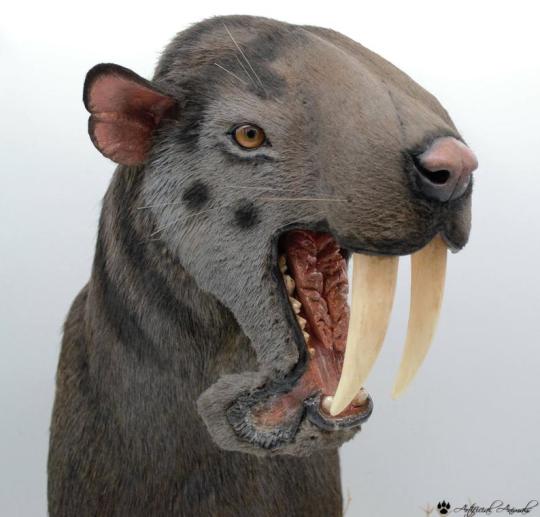
I love seeing reconstructions of these guys because their skulls are so weird.
82 notes
·
View notes
Photo

#UnscienceAnAnimal
92 notes
·
View notes
Photo
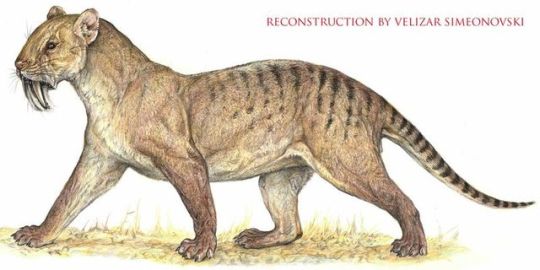
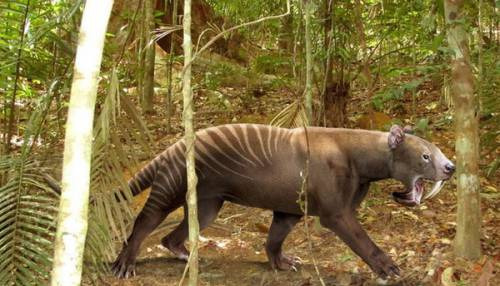


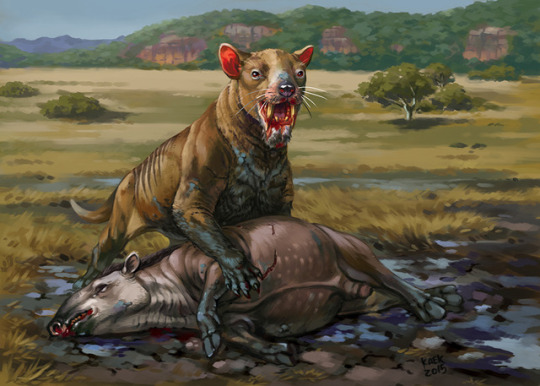
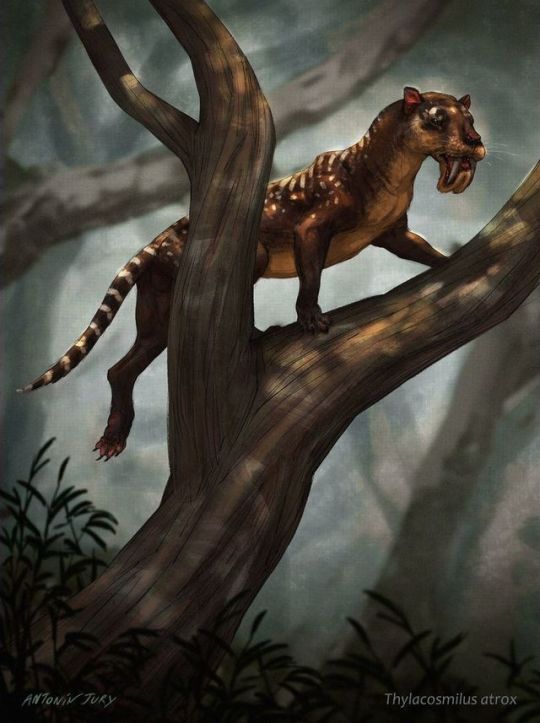
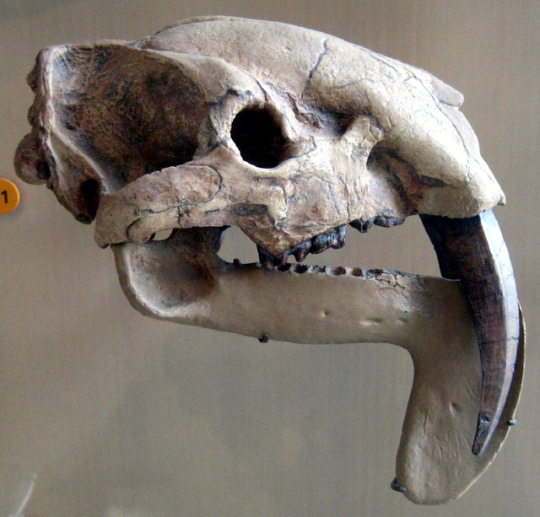

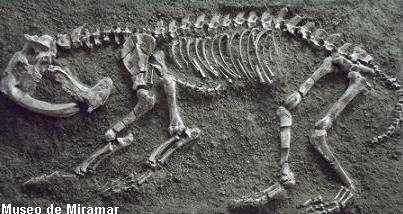
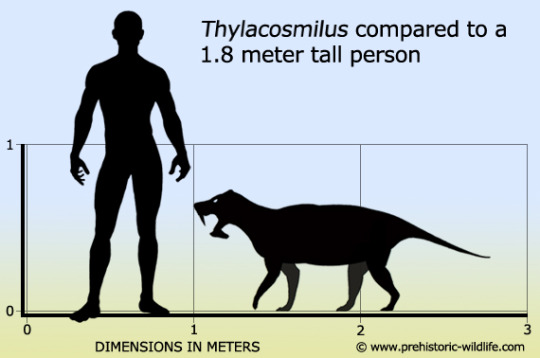
Thylacosmilus atrox is an extinct species of saber-toothed metatherian that inhabited South America from the late Miocene to Piacenziane. Though Thylacosmilus is one of several predatory mammal genera typically called "saber-toothed cats", it was not a felid, but a sparassodont, a group closely related to marsupials, and only superficially resembled other saber-toothed mammals due to convergent evolution. Based on studies of its habitat, Thylacosmilus is believed to have hunted in savannah-like or sparsely forested areas.
Thylacosmilus had large, saber-like canines. The roots of these canines grew throughout the animal’s life, growing in an arc up the maxilla and above the orbits. Body mass estimates of Thylacosmilus suggest this animal weighed between 180–260 pounds, and one estimate suggesting up to 330 pounds, about the same size as a modern jaguar. This would make it one of the largest known carnivorous metatherians.
Recent comparative biomechanical analysis have estimated the bite force of T. atrox starting at maximum gape at 38 newtons (8.5 lbf), much weaker than that of a leopard, suggesting its jaw muscles had an insignificant role in the dispatch of prey. Its skull was similar to that of Smilodon in that it was much better adapted to withstand loads applied by the neck musculature, which, along with evidence for powerful and flexible forelimb musculature and other skeleton adaptations for stability, support the hypothesis that its killing method consisted on immobilization of its prey followed by precisely directed, deep bites into the soft tissue driven by powerful neck muscles.
#prehistoric mammals#prehistoric predators#prehistoric carnivores#thylacosmilus atrox#not a saber-toothed cat#convergent evolution
147 notes
·
View notes
Photo

MAÑANAS CAMPESTRES ✍🏻 Técnica tradicional mixta: Tinta, acuarelas, y lápices de colores sobre papel. ☝🏻 Esta obra forma parte de la exhibición de paleoarte en el marco de las XXXV JAPV (Jornadas Argentinas de Paleontología de Vertebrados). Pueden ver la galería junto con el resto de las obras expuestas por otros paleoartistas latinoamericanos aquí: https://events.mef.org.ar/galeria-de-paleoarte/ 🌫️ Es una mañana tormentosa del Mioceno tardío en un pastizal en las proximidades de lo que será la Formación Ituzaingó de la Cuenca del Paraná, y una madre Andalgalornis steulleti protege a sus polluelos de un joven Thylacosmilus atrox hambriento, que se verá obligado a continuar su búsqueda de alimento en otra parte. (en Entre Rios, Argentina) https://www.instagram.com/p/CdwFthZv7h7/?igshid=NGJjMDIxMWI=
0 notes